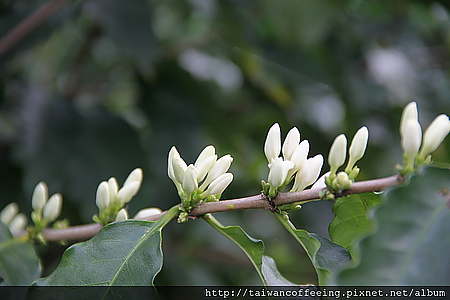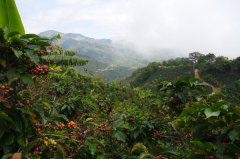Coffee planting and cultivation techniques Arabica coffee how to plant coffee seeds and how to grow into trees

Professional coffee knowledge exchange More coffee bean information Please pay attention to coffee workshop (Weixin Official Accounts cafe_style)
A coffee tree bears fruit several times a year Coffee trees are planted.
Coffee trees are sensitive to climate, sunlight, rain, and soil. When a coffee bean sprouts upward and takes root downward in the soil, it will squeeze the bean out of the soil. After a few days, two leaves will grow on the top of the bean. Finally, the empty shell will fall off, and a new coffee seedling will be born.
The new coffee seedlings will be put into the cultivation pot, moved to the nursery, and have their own side of the world. In Taiwan, coffee nursery shelves are often covered with black gauze to protect young seedlings from direct sunlight. After one year, the young trees gradually step out of the greenhouse and transplant to the cultivation site, directly facing the test of nature. In Taiwan, it is usually transplanted to plains, low-elevation tableland, hillsides, or high-elevation hillsides.
After coffee tree planting, it began its growth and development period. After proper propagation and cultivation management, it began to bloom and bear fruit in about 2 to 4 years, and entered the peak period in about 6 years. According to the data of coffee experiment introduced by Japanese in 1930s, the time period here is mainly based on the experiment of early agricultural experiment field, and the current flowering and harvest situation still depends on the altitude and climate of each growing area in Taiwan.
Coffee is planted by selecting seeds for planting and growing them in seedbeds, which usually germinate within 6 to 8 weeks. After a year of cultivation in nurseries, coffee seedlings are transplanted to plains, terraces or hillsides. Because direct sunlight can damage seedlings and turn leaves yellow, it is usually necessary to reduce sunlight to protect seedlings. In Taiwan, nursery scaffolding is usually covered with black gauze to block sunlight.
Coffee requires annual rainfall of between 1,500- 2,000 mm. Taiwan's rainfall sources are roughly concentrated in the Meiyu season from May to June and the typhoon season from July to September. The annual average temperature is 28--29℃ in summer, 16℃ in Taipei and 19--20℃ in Kaohsiung in winter.
Plain terrain is usually protected by shade trees because of strong sunlight. Direct sunlight can kill coffee flowers, possibly leaving them unpowdered and producing empty pods. Banana trees are commonly used as shade trees abroad, while areca trees, acacia trees, tung trees, rubber trees or persimmon trees are commonly used as shade trees in Taiwan. And common have leaf, tea tree, orange tree intercropping, early even sugar cane, sweet potato intercropping.
Seedbed had better choose flat and slightly inclined, easy irrigation, and good drainage site. The soil characteristics of coffee planting are best between pH 4.2- 5.1, which is a strong acidic soil. Warm temperatures of about 15 - 25℃ are most suitable. Arabica coffee is grown at a height of about 2,500 meters if it is planted near the equator; if it is planted near the Tropic of Cancer, it can be cultivated at a height of about 300--1,000 meters, but it must still pay attention to frost damage.
Robusta coffee requires higher temperatures and humidity than arabica. Coffee growers in Taiwan are most afraid of encountering typhoon season every year, because coffee trees have shallow roots and are easily affected by windstorms. The growth of coffee trees blown down will be hindered. In Taiwan, the whole leaves of coffee trees damaged by windstorms turn yellow or even die. And planting bamboo forest can prevent strong wind.
Coffee is grown at high altitudes where there is no full sun and cloud cover, usually without shade trees. At higher altitudes in Taiwan, there are betel nut trees, tea trees, and other intercropping trees, or tung trees, acacia trees, and other shade trees. Because of serious soil erosion on hillsides, it is helpful to soil and water conservation if it is planted together with shade trees.
。
Important Notice :
前街咖啡 FrontStreet Coffee has moved to new addredd:
FrontStreet Coffee Address: 315,Donghua East Road,GuangZhou
Tel:020 38364473
- Prev

The relationship between the growth altitude of Coffee planting and the Flavor of Coffee
Professional coffee knowledge exchange more coffee bean information please follow the coffee workshop (Wechat official account cafe_style) A coffee tree bears fruit several times a year. Raw beans are generally graded according to their size, defect rate, and altitude. The size and defect rate of raw beans are easy to understand, and many people do not quite understand why some producing areas are graded according to the altitude at which coffee beans grow.
- Next

Starting from Coffee cultivation-the upcoming planting and Environmental problems in Coffee growing areas in Yunnan
Professional coffee knowledge exchange more coffee bean information please follow the coffee workshop (Wechat official account cafe_style) A coffee tree bears fruit several times a year. Coffee is one of the agricultural products, and its yield varies by region, climate, altitude, planting mode and other factors. From coffee sweeping the world to becoming the most popular drink in western countries, the whole world
Related
- Beginners will see the "Coffee pull flower" guide!
- What is the difference between ice blog purified milk and ordinary milk coffee?
- Why is the Philippines the largest producer of crops in Liberia?
- For coffee extraction, should the fine powder be retained?
- How does extracted espresso fill pressed powder? How much strength does it take to press the powder?
- How to make jasmine cold extract coffee? Is the jasmine + latte good?
- Will this little toy really make the coffee taste better? How does Lily Drip affect coffee extraction?
- Will the action of slapping the filter cup also affect coffee extraction?
- What's the difference between powder-to-water ratio and powder-to-liquid ratio?
- What is the Ethiopian local species? What does it have to do with Heirloom native species?

